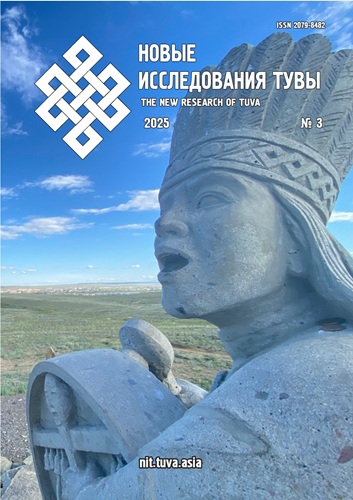Alliteration in 20th-Century Tatar Poetry
DOI:
https://doi.org/10.25178/nit.2025.3.10Keywords:
alliterative verse; Tatar poetry; versification; syllabism; initial alliteration; intralinear alliteration; line-initial alliterationAbstract
This article explores the role and functions of alliteration as a structural device in the works of Tatar poets from various periods of the 20th century. The analysis focuses on the poetry of Gabdulla Tukay, Khasan Tufan, Ildar Yuzeev, and Lilia Gibadullina, enabling the identification of the evolution of alliterative techniques from folklore traditions to individualized poetic strategies. Special attention is given to the influence of historical and cultural factors, such as the shift in versification systems (from aruz to syllabic verse), as well as interactions with Eastern and Turkic poetic traditions.
The study considers different forms of alliteration — anaphoric, intralinear, and line-initial — and their functions: enhancing the musicality of verse, amplifying emotional impact, imitative sound effects, semantic emphasis, and the shaping of a national poetic style. A comparative analysis of the works of key 20th-century poets demonstrates that alliteration remains a significant element of sound organization, even amid the dominance of rhyme and the modernization of versification practices.
It is emphasized that the use of alliteration in Tatar poetry is connected not only with the preservation of ethnic traditions but also with the search for new expressive possibilities, reflecting broader trends in the development of Turkic literatures.
The research is grounded in a wide range of theoretical and historical-literary sources, as well as in close readings of specific poetic texts, thereby offering a comprehensive perspective on the functioning of alliteration in 20th-century Tatar poetry.
References
Zhirmunsky, V. M. (1970) On Certain Problems of the Theory of Turkic Folk Verse. In: Kononov, A.N. (ed.) Turkological Collection–1970. Moscow, Nauka, Main Editorial Board of Oriental Literature. 285 p. Pp. 29–68. (In Russ.)
Kurbatov, Kh. R. (1984) Language, Style, Metrics and Strophics in Old Tatar Poetry. Kazan, Tatar Book Publishing House. 164 p. (In Tatar.)
Kurbatov, Kh. R. (2005) Rhythmics of Tatar Verse. Kazan, Alma-Lit. 89 p. (In Russ.)
Rodionov, V. G. (2024) Evolution of Chuvash Verse and That of Their Ancestors in the Context of Historical Stages of Renewed Paradigms. In: Ibragimov, M. I. (ed.) Poetics of the Literatures of the Peoples of the Urals and the Volga Region. Kazan, IYALI. 304 p. Pp. 162–185. (In Russ.)
Stebleva, I. V. (1965) The Poetry of the Turks in the 6th — 8th Centuries. Moscow, Nauka. 146 p. (In Russ.)
Usmanov, Kh. U. (1984) Ancient Origins of Turkic Verse. Kazan, Kazan University Press. 148 p. (In Russ.)
Khamraev, M. K. (1963) Fundamentals of Turkic Versification (Based on Classical and Modern Uyghur Poetry). Alma-Ata, Publishing House of the Academy of Sciences of the Kazakh SSR. 216 p. (In Russ.)
Published
How to Cite
For citation:
Zagidullina D. F. Alliteration in 20th-Century Tatar Poetry. New Research of Tuva, 2025, no. 3, pp. 148-165 (In Russ.). DOI: https://doi.org/10.25178/nit.2025.3.10
Issue
Section

This work is licensed under a Creative Commons Attribution-NonCommercial 4.0 International License.

Author(s) license holder(s) grant rights for their work to the journal (grantee of a license) under the simple non-exclusive open license in accordance with Art. 1286.1 «Open license for a research work, work of literature or fine arts», Civil Code of the Russian Federation.
New Research of Tuva publishes articles under the Creative Commons Attribution-NonCommercial license (CC BY-NC).
Since it is an open license, author(s) reserve the right to upload the article to their institutional repository, submit it to another journal (if it allows republications), or republish it on their own website (in full, or in part).
However, several conditions apply here:
a) The republished version must always contain the name(s) and affiliation(s) of the author(s), the original title and the hyperlink to the original version on the New Research of Tuva website;
b) It must be in open access, free of charge, and no category of readers must be in any way whatsoever advantaged over general readership.
c) should the contribution be submitted elsewhere by its author(s) without substantial modification (30% or more of original text unchanged), the body of the article should contain a disclaimer that the original version was published in New Research of Tuva (with a link to the respective page)
The CC-BY-NC is a non-revocable license which applies worldwide and lasts for the duration of the work’s copyright.









